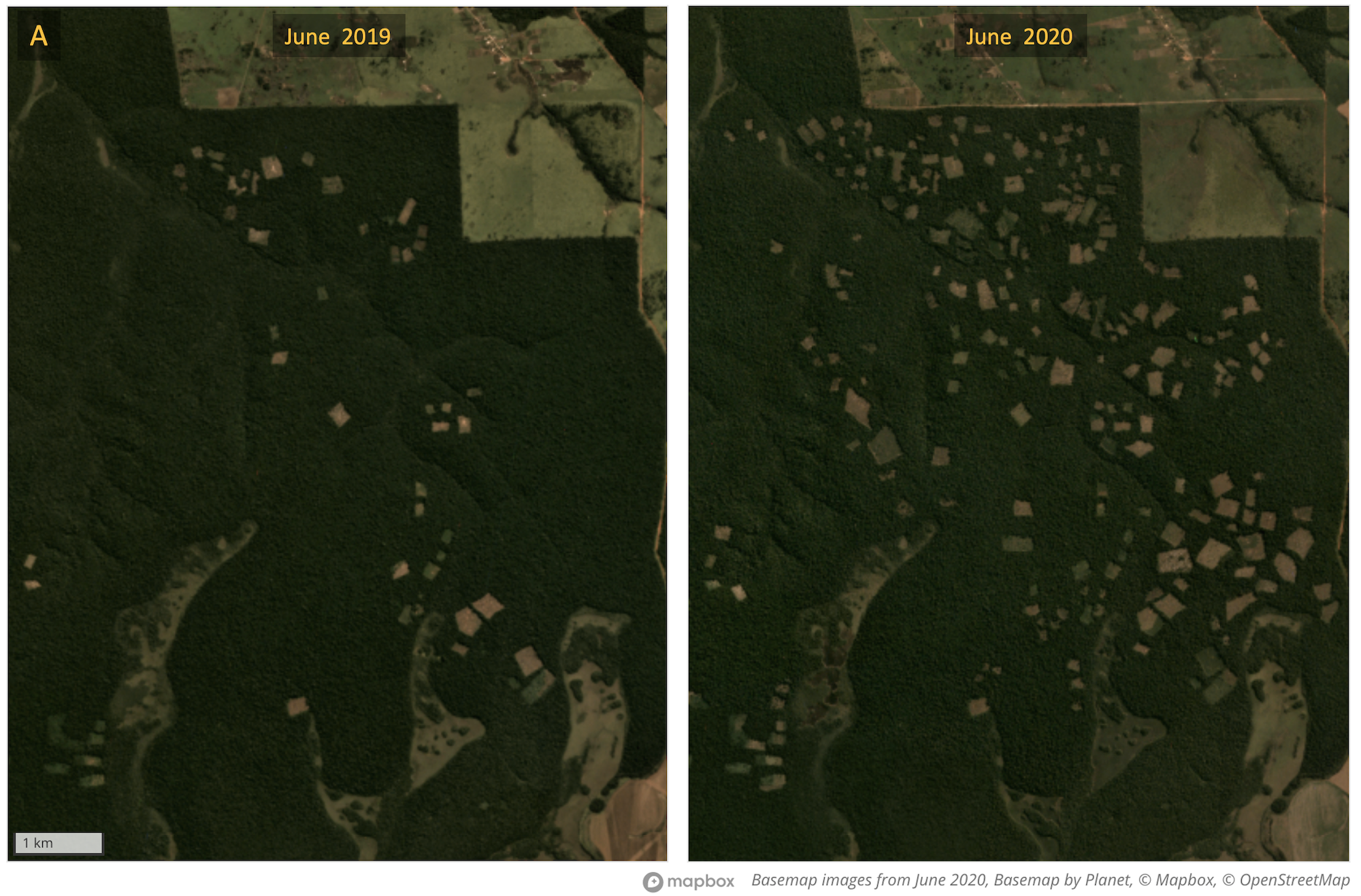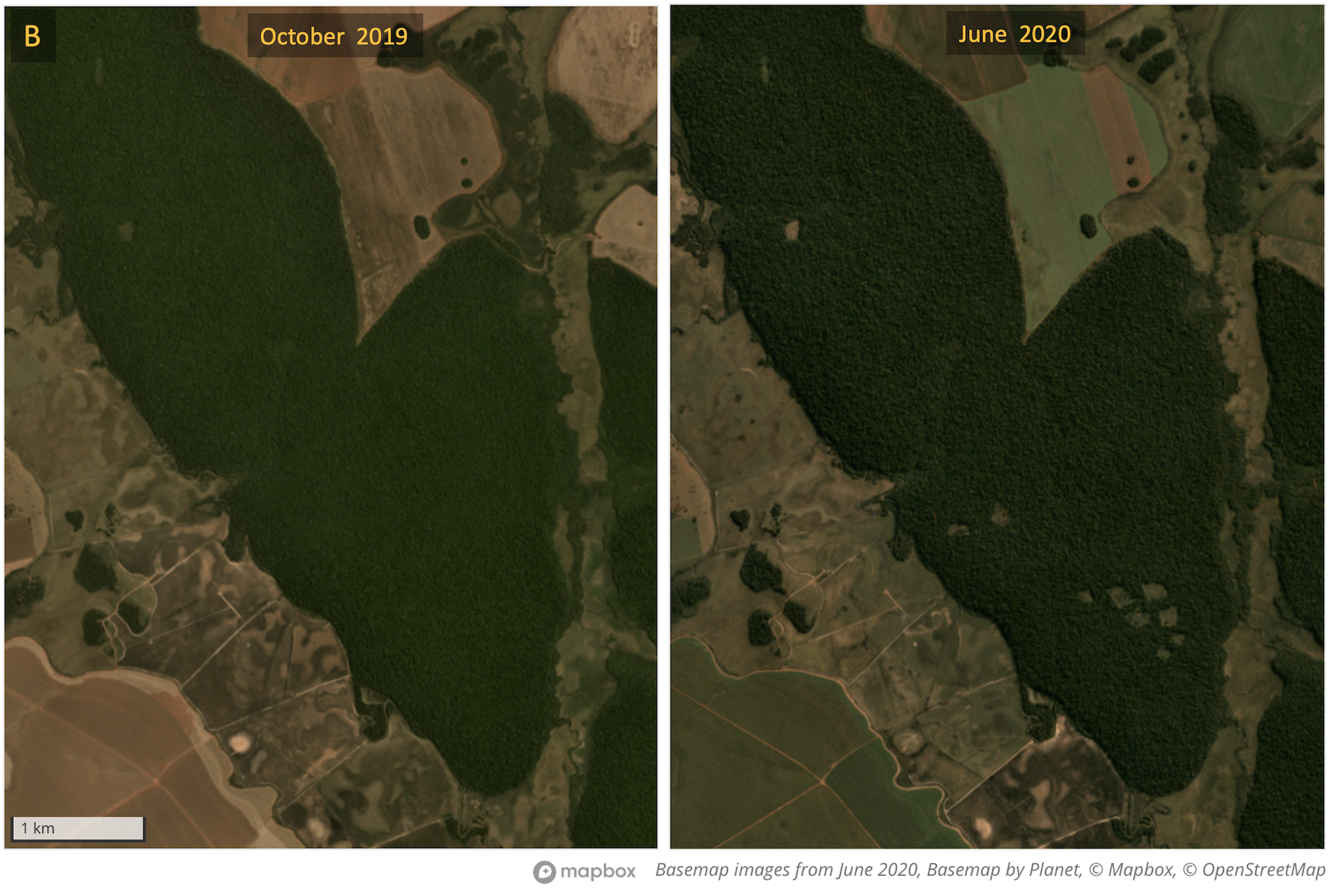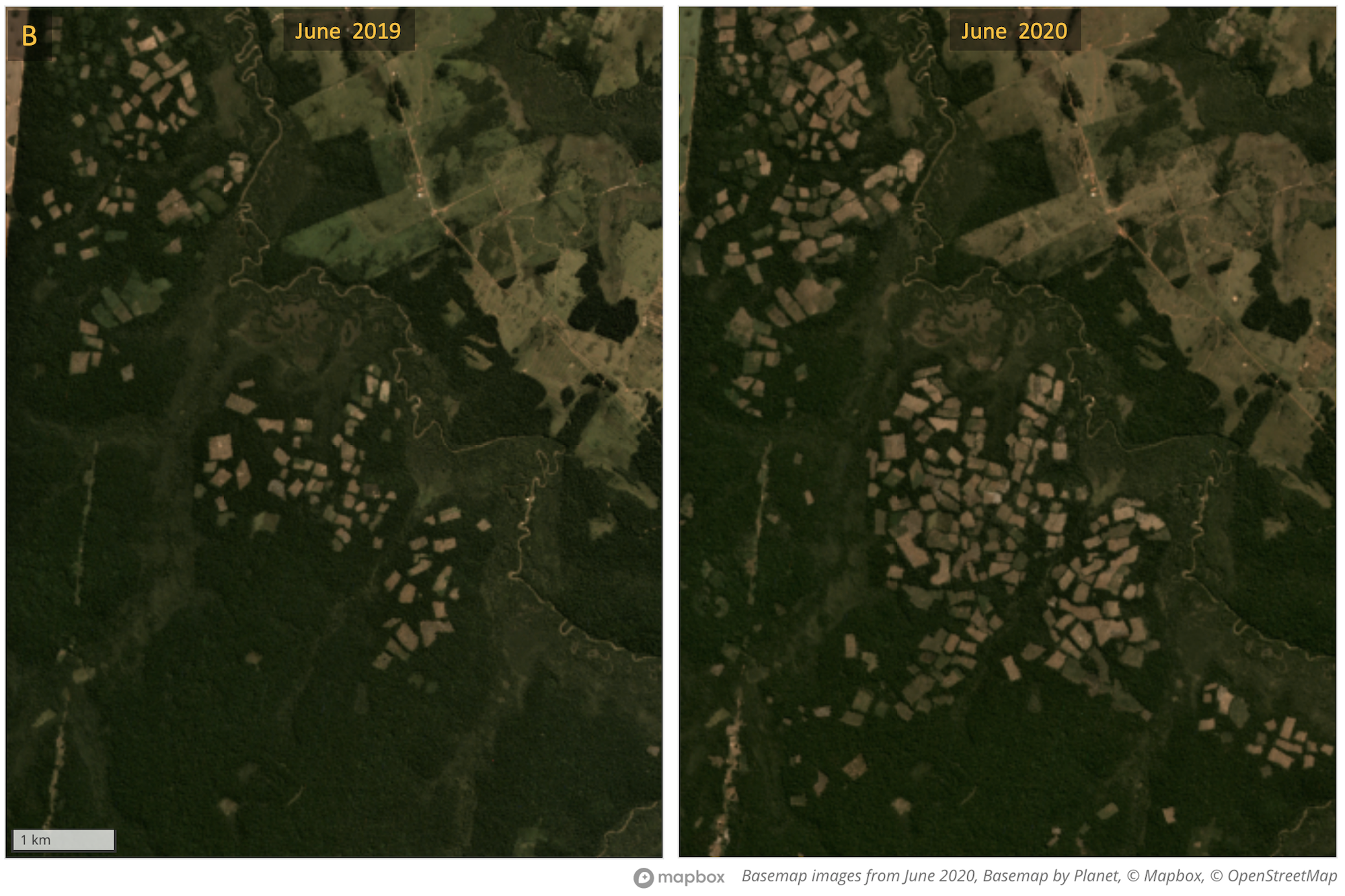- Agriculture has deforested much of eastern Paraguay’s Upper Parana Atlantic Forest, an endangered ecoregion of which less 10% remains today.
- More recently, illegal marijuana cultivation has become a driving force of deforestation in the region. Even protected areas are not immune from destruction, with satellite data and drone footage confirming large swaths of protected primary forest have been cleared for marijuana cropland over the past year. Sources say timber and charcoal are also being produced as by-products of clearing for marijuana and are illegally transported out of protected areas.
- Four protected areas have been particularly affected: Mbaracayú Reserve, San Rafael National Park/Proposed National Reserve, Morombí Reserve and Caazapá National Park.
- Forest rangers working in the protected areas say there aren’t enough enforcement staff to combat the illegal encroachment.
This story is a collaboration between La Nación and Mongabay Latam. It is the second installment of a five-part series on illegal deforestation for marijuana production in eastern Paraguay. Read the first, third, fourth and fifth parts.
TAGUATÓ, Paraguay — The Upper Parana Atlantic Forest is one of the world’s most endangered forests. The ecoregion has been almost entirely cleared in Brazil, and Argentina holds the largest remaining areas of connected habitat. In Paraguay, studies estimate less than 10% remains, mostly as fragmented forest islands scattered across a largely unprotected, denuded landscape.
Agriculture is the driving force of deforestation in Paraguay, with much of the country’s forests cleared legally to make way for cattle, soy, corn and sugar cane fields over the past half-century. But clearing for illicit marijuana cultivation is also taking a toll on the eastern Paraguay’s forests. According to the National Anti-Drug Secretariat (SENAD), 81,871 kilos (180,494 pounds) of marijuana were seized and 797 forest parcels were destroyed in Paraguay’s portion of the Upper Parana Atlantic Forest between 2015 and 2020. Investigation by Mongabay and La Nación found marijuana farms carved out of several national parks and reserves in eastern Paraguay.
Despite a deforestation ban enacted in 2004, eastern Paraguay lost approximately 1.2 million hectares (about 3 million acres) of tree cover between 2001 and 2018, according to satellite data from the University of Maryland. Park rangers in eastern Paraguay estimate that at least 2,350 hectares (about 5,805 acres) of marijuana crops have been planted within four national parks and reserves in Paraguay’s Upper Parana Atlantic Forest: Mbaracayú Reserve, San Rafael National Park/Proposed National Reserve, Morombí Reserve and Caazapá National Park. According to data from the World Wildlife Fund (WWF), these four parks and reserves have lost a total of 9,107 hectares (about 22,500 acres) of forest since the deforestation ban went into effect.
Fernando Crug, a director from SENAD, says that Brazil continues to be the main recipient of the marijuana that leaves Paraguay.
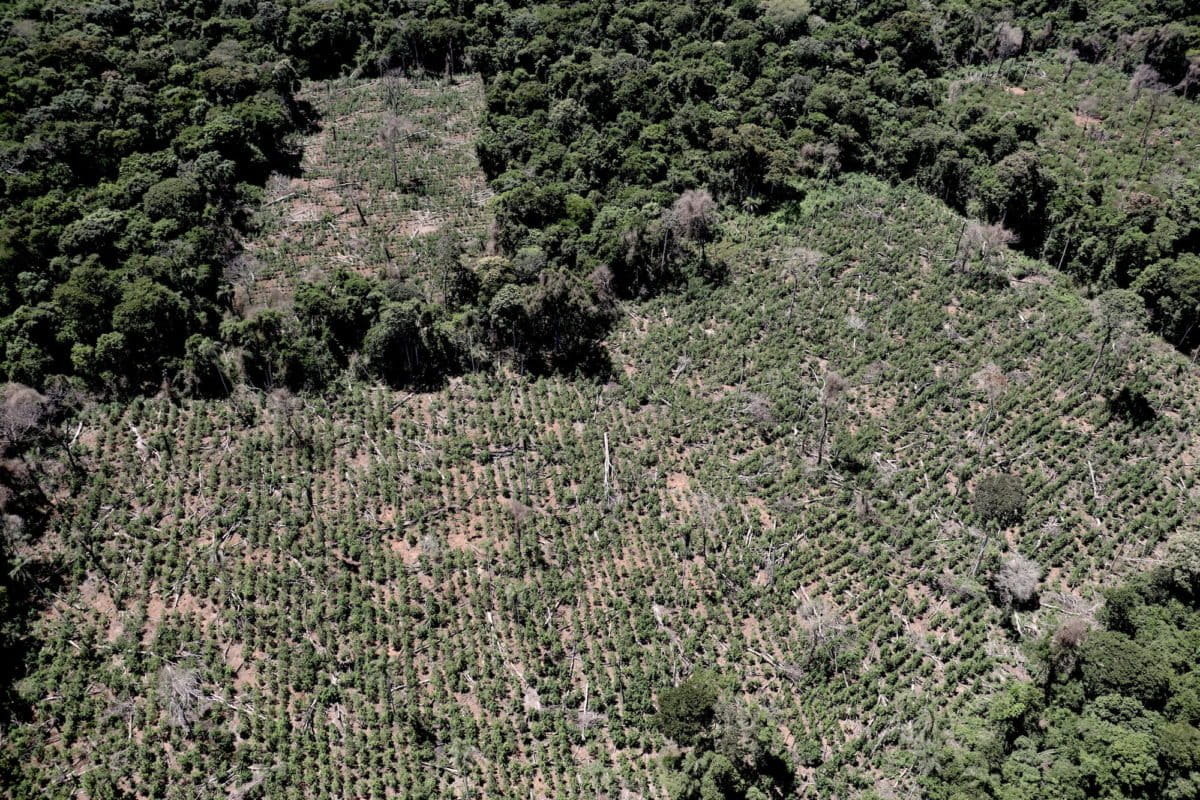
Morombí
Morombí Natural Reserve covers approximately 24,800 hectares (about 61,280 acres) and belongs to an agroindustrial company called Campos Morombí. Its territory includes land in the departments of Canindeyú and Caaguazú and it is part of the National System of Protected Wild Areas of Paraguay (SINASIP).
According to satellite data from the University of Maryland, Morombí lost nearly 4,000 hectares (about 9,800 acres) – or 15% – of its tree cover between 2012 and 2019. Half of this loss occurred in 2019 alone. Satellite data and imagery show the reserve may be in for another year of heavy deforestation in 2020, with clearing continuing into July.

WWF research indicates the deforested land was used for marijuana cultivation, coal production, and human settlements. Records from the National Anti-Drug Secretariat (SENAD) of Paraguay show 18,130 kilograms (about 40,000 pounds, or almost 20 tons) of marijuana was destroyed in the reserve between 2015 and 2019.
In February, SENAD agents descended on one such operation and destroyed over 660 tons of marijuana plants spread over 202 hectares (about 500 acres) of land. Some of the marijuana plants exceeded two meters (over six feet) in height and 10 centimeters (almost four inches) in diameter.
“It has been ages since I’ve seen trunks and stems like these,” said a SENAD official who attended the operation.
Those who know the area said that there are at least another 1,000 hectares (about 2,470 acres) of marijuana crops inside the reserve. Despite being an area included in SINASIP, no government-managed park rangers work within Morombí; instead 14 guards who work for Campos Morombí are tasked with monitoring the reserve.

In 2013, a park ranger named Bruno Chevugi was murdered in nearby Mbaracayú Forest Nature Reserve. Park rangers from other reserves in eastern Paraguay, such as in Morombí, say they work with the knowledge that their lives are at stake.
“Not many people want to work as park rangers because they know the problems,” said Morombí’s head of security. “It is difficult to get people who want to come.”
Charcoal production has also been increasing in Morombí over the past few years. Park rangers say there is evidence that marijuana traffickers may work in coordination with charcoal producers, and that charcoal is being made from trees that are cut down to make room for the marijuana crops but are not valuable enough to sell to timber markets. Environmental attorney Osvaldo García says a “clandestine industry” has been formed in Morombí and other reserves.
Despite evidence that marijuana has been illegally cultivated in Morombí for years, Canindeyú district records indicate only one judicial investigation into the matter has occurred, which was initiated in 2019 and is ongoing.
San Rafael
The San Rafael protected area is located between the departments of Itapúa and Caazapá and administered by a small conservation organization called Pro Cosara. Comprising some 73,000 hectares (180,385 acres) it is one of eastern Paraguay’s largest protected areas. However, despite its recognition as a national park by the World Database of Protected Areas and researchers, its legal status in Paraguay is nebulous. The issue stems from a 2002 designation change that sought to switch San Rafael’s status from “national park” to “proposed national reserve.” However, Darío Mandelburger, the director of the General Directorate for the Protection and Conservation of Biodiversity within the Ministry of the Environment, says no such category legally exists in Paraguay’s environmental legislation.
“This caused a serious problem,” Mandelburger said, as the ambiguity formed a legal vacuum that circumvented the enforcement of environmental protection laws in the park.
The San Rafael core zone, which is supposed to be untouchable, has been disappearing slowly over time. In 2015, the National Institute of Rural and Land Development (INDERT) discovered approximately 80 farming families living illegally inside the area. Since then, small areas have been cleared to plant corn, soybeans, sugar cane, and cassava.
According to Víctor González Segovia, a technician from the National Forestry Institute (INFONA) of Paraguay, marijuana parcels can be distinguished from those cleared for other crops as the former are established more quickly and the distances between the parcels are shorter.
When walking along San Rafael’s trails, one can see native trees that have grown there for over 200 years, such as the Pacara earpod tree (Enterolobium contortisiliquum). In the past few years, however, researchers say marijuana crops have supplanted this native forest and damaged wildlife habitat.
According to satellite data from the University of Maryland, San Rafael lost some 6,000 hectares (about 14,800 acres) of tree cover between 2004 and 2019, amounting to some 10% of its total forest cover. The vast majority of this loss happened in just two years – 2017 (1,850 hectares) and 2019 (1,980 hectares). Preliminary data for 2020 show deforestation may be trending even higher this year, with more tree cover loss detected between January and July 2020 than during the same period last year.
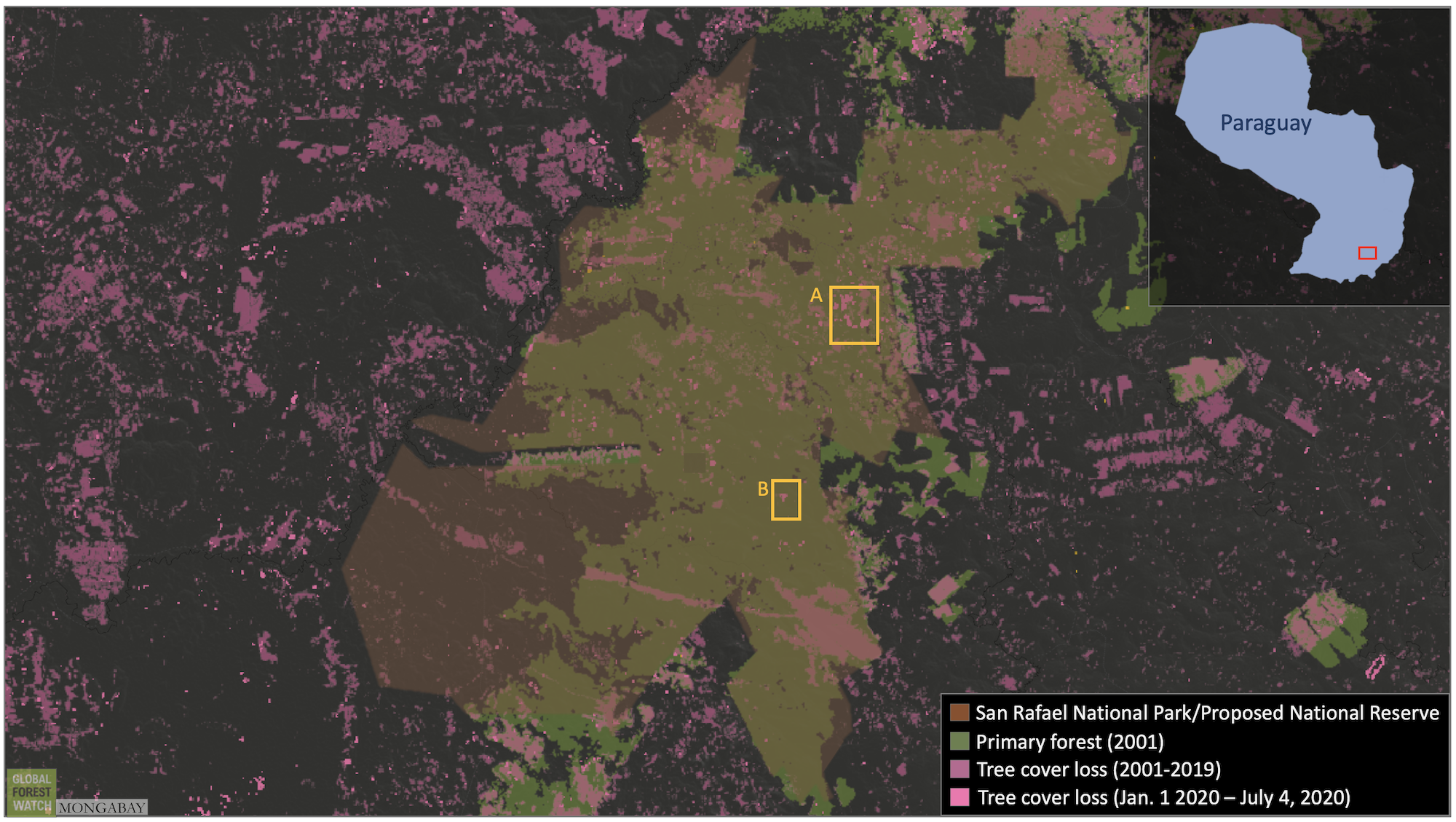
According to WWF, the primary driver of this surge in deforestation is to make room for marijuana crops. Marijuana crops growing in clearings of between four and 30 hectares (10 and 50 acres) in size were observed via drone by Mongabay and La Nación reporters in San Rafael near the community of Taguató. SENAD records show that 48,931 kilograms (about 107,875 pounds, or almost 54 tons) of marijuana were seized from San Rafael between 2015 and 2019.
Timber trafficking is also a threat to San Rafael. Park rangers said the transport of timber out of the area intensified after the 2019 construction of a bridge across the Tebicuary River, with traffickers generally mobilizing at night and using tractors to remove tree trunks from the protected area. Once they are outside the boundary of San Rafael, the traffickers load the logs onto trucks that take them to sawmills in the department of Caazapá. The tree species that are most sought-after by the traffickers are the yvyrapytã (or “ibirá-pitá”) (Peltophorum dubium) and the pink lapacho (Handroanthus impetiginosus).
Rangers said that in some cases, the traffickers even improvise secret sawmills in the middle of the forest to cut and process the timber and then remove it using cars or trucks.
“They take advantage of working with chainsaws when it rains or when there is a storm, so that not much can be heard,” said one of the park rangers. He added that it is not easy to intervene at the exact moment that the forest is being destroyed as there are only seven active park rangers who take turns monitoring the San Rafael’s 73,000 hectares (about 180,385 acres).

Another ranger said all seven have received threats from timber traffickers, and that their job is made even more difficult because they lack support from the authorities due to San Rafael’s ambiguous legal status.
“It is very difficult for us to control the whole area,” the ranger said, “and it is even more difficult if no authorities support us in preventing timber extraction and marijuana cultivation.”
Caazapá
Less than 10 km to the north of San Rafael is Caazapá National Park, which is located in the Caazapá department in southern Paraguay and within the mountains of the Cordillera de Caaguazú. Caazapá National Park is separated into two distinct blocks: one of 10,000 hectares (about 24,710 acres) and one of 6,000 hectares (about 14,825 acres). The park also contains the headwaters of three of eastern Paraguay’s most important rivers: Monday, Ñacunday and Tebicuary.
According to satellite data, Caazapá National Park lost 1,130 hectares (1,800 acres) of tree cover between 2001 and 2019, amounting to nearly 9% of its forest cover. The data show that like San Rafael, the majority of deforestation in Caazapá happened in 2017 and 2019; in 2019 alone, the park lost nearly 4% of its tree cover.
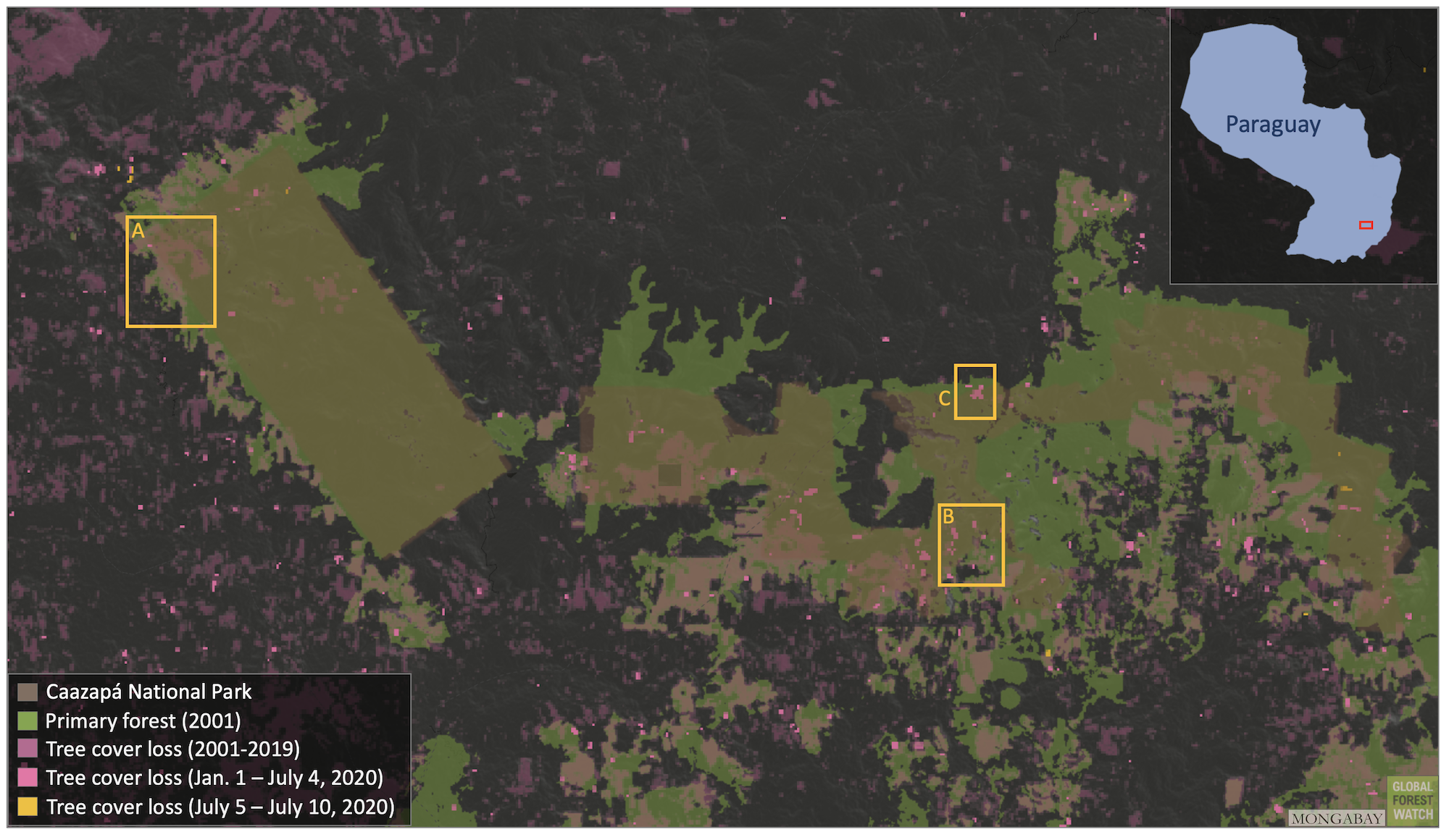
Park rangers report that marijuana has been a recurring problem in both blocks over the past few years, and is coming at the expense of the park’s native forest. According to SENAD records, 14,500 kilograms (about 32,000 pounds, or almost 16 tons) of marijuana was seized from inside Caazapá National Park between 2015 and 2019, the majority of which (13,500 kg) was seized during a single operation in May 2019. That operation, like several others before it, did not result in any arrests.
Sources say deforestation has had a profound effect on the park’s wildlife.
“There are fewer and fewer [animals],” a park ranger told Mongabay. “Also, with the last fire that we had, many died,” he said, referring to forest fires that destroyed some 300 hectares (740 acres) in Caazapá in 2019.
Five active park rangers are tasked with monitoring all 16,000 hectares (about 39,535 acres) of Caazapá National Park, who are overseen by the Paraguayan government. Due to violence against environmental workers, many wear bulletproof vests when on the job. There is precedent for their fear; in 2018, park rangers Rumildo Toledo and Artemio Villalba were shot and killed in the Tapytá Nature Reserve, which is also in the Caazapá department.
Spread thin and facing threats, Caazapá rangers say they can’t fight the tide of marijuana cultivation in the park.
“We know that there is not much we can do,” one ranger told Mongabay.

Marijuana isn’t the only crop displacing forest in and around the park. Caazapá’s buffer zone — a strip of protected land that surrounds the perimeter of the park — has also been invaded by soybean crops. Almost all of the area’s residents have rented out some of their land for soybean farming, according to the residents themselves.
Farming is legal in the buffer zone with an approved forest management plan from the Ministry of the Environment. However, agency representatives say they do not have documentation of any plan to work in that area.
Mbaracayú
Mbaracayú Forest Nature Reserve spans 64,405 hectares (about 159,150 acres) and is located in the Canindeyú department, just across the border from Brazil. This protected area has become a supplier of marijuana, timber, and charcoal for the neighboring country.
Mbaracayú lost nearly a third of its forest cover between 2001 and 2019, according to satellite date from the University of Maryland, and preliminary data show 2020 is on track to be another banner year for deforestation in the reserve. Sources say much of Mbaracayú’s land is being cleared to plant marijuana and produce charcoal. Traffickers then smuggle charcoal and marijuana into Brazil, according to Julio Mareco, the director of environmental auditing in the Ministry of the Environment.
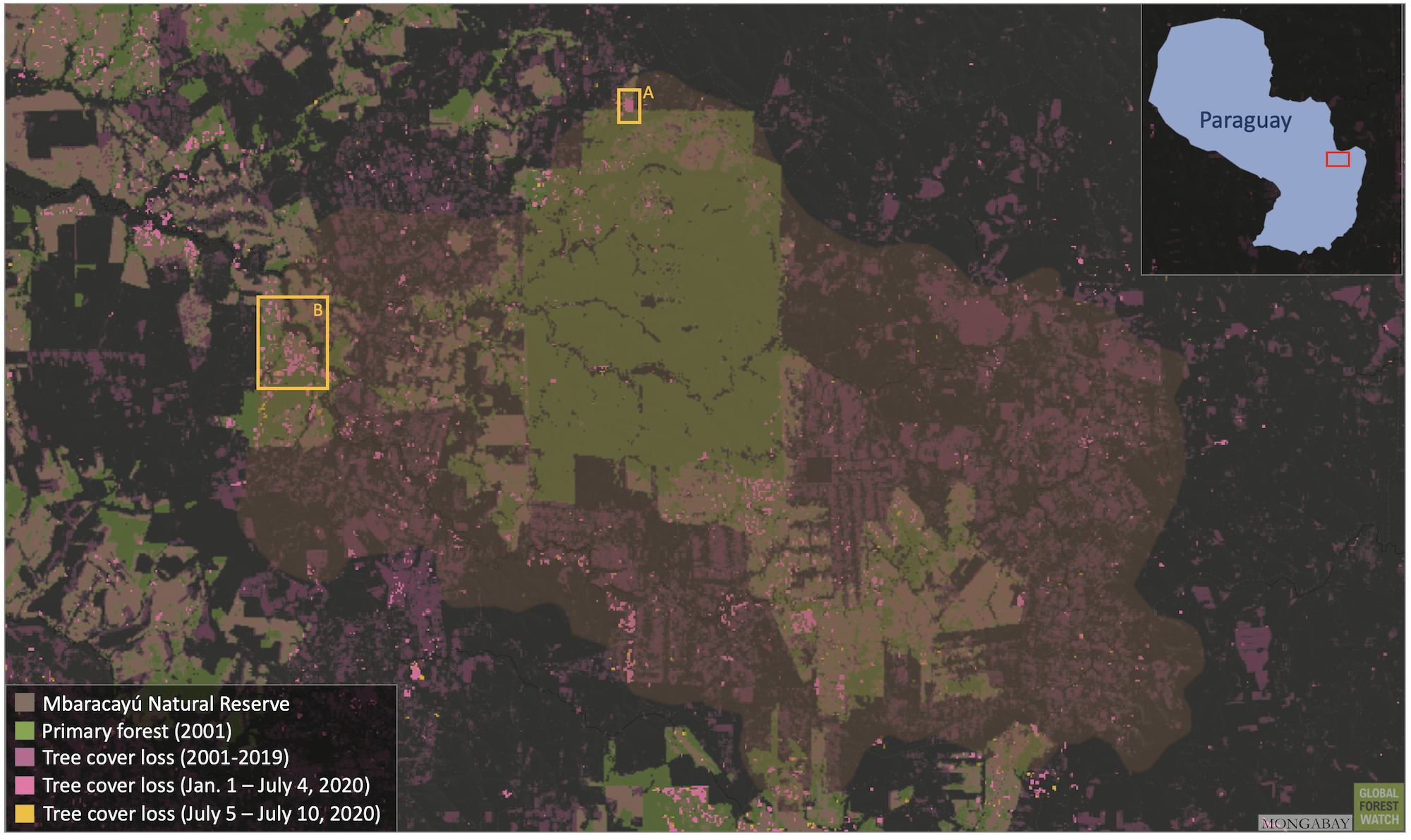
Mbaracayú has more active park rangers than any other reserve in Paraguay, with a total of 21. Nonetheless, illegal deforestation remains a problem.
“[Marijuana growers] practically operate without fear because nobody does anything about them,” a park ranger told Mongabay.
Marijuana crops are easily accessed in the reserve, with some plots located just meters away from a new road that connects the cities of Curuguaty-Villa and Ygatimí -Ypejhú. To curtail the practice, rangers have set up camps near known plots to monitor illegal cultivation. However, department records indicate no judicial investigation has taken place despite a litany of complaints.

SENAD officials say the agency has documented 107 hectares (about 265 acres) of illegal crops in Mbaracayú and seized 421 kilograms (about 930 pounds) of marijuana between 2015 and 2020, which is a small amount when compared to that seized from other protected areas in the region.
Representatives of the organizations that work in all four protected areas declined to comment, explaining that they prefer to avoid sharing their opinions in order to protect those working in the field.
Augusto Salas, a deputy environmental prosecutor for the Public Ministry of Paraguay, said there are very powerful organizations behind these illegal crops and that every day more and more people are joining the illicit industry.
“We have already discussed this with those in the Senate [of Paraguay] and with other authorities,” said Salas, adding that deployment of military units to the country’s protected areas may be the only way to save them.
This is a translated and adapted version of a story that was first published by Mongabay Latam on May 26, 2020.
Banner image by Pánfilo Leguizamón.
Editor’s note: This story was powered by Places to Watch, a Global Forest Watch (GFW) initiative designed to quickly identify concerning forest loss around the world and catalyze further investigation of these areas. Places to Watch draws on a combination of near-real-time satellite data, automated algorithms and field intelligence to identify new areas on a monthly basis. In partnership with Mongabay, GFW is supporting data-driven journalism by providing data and maps generated by Places to Watch. Mongabay maintains complete editorial independence over the stories reported using this data.
Feedback: Use this form to send a message to the editor of this post. If you want to post a public comment, you can do that at the bottom of the page.

